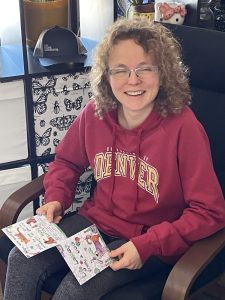
Our now 32 year old daughter, Michaela, hasn’t had the same road with food allergies as her brother has had. However, she has suffered from food intolerances, Attention Deficit Disorder, Dyslexia, Irritable Bowel Syndrome, Celiac Disease and received many other diagnoses during her childhood. It hasn’t been an easy road for her either.
I have much anecdotal evidence regarding food allergic children and their siblings. I hear from so many families that they have one child who is food allergic and the other who is diagnosed with learning disabilities and both children end up with accommodation needs in school! To date, I have yet to see research on this phenomenon, but there appears to be many families with these issues coexisting.
Food intolerances, we have found, generally affect the gut. We’ve also found that it becomes a guessing game as to what the problem food is, eliminating the food and then seeing if symptoms decrease.
Our story of food intolerances begins with…
An Eventful Pregnancy and Early Life Adjustments
During my pregnancy with Michaela, my gallbladder ‘gave out’ at about 7 months of gestation. I was in enormous back pain, received an ultrasound, where a large stone was found in my gallbladder. For the remaining 3 months of the pregnancy, I was put on a fat-free diet. In 1990, there wasn’t the availability of fat free foods, and I began to lose weight trying to find food that I could eat. Michaela’s little feet continued to dance on my gallbladder to the point that I was in pain 24 hours a day. My obstetrician determined at 38 weeks that enough was enough and labor was induced.
Michaela was born with bruises, (probably from the vacuum extraction process) and ended up with a severe case of jaundice. She got to sunbathe under lights for 24 hours at one week old, and the jaundice disappeared.
Because of my fat free diet, I produced no breast milk at all. She was therefore put on soy milk formula because of milk allergies in the family. She didn’t tolerate soy at all, and we switched her to Enfamil (a milk based formula). She tolerated this better, however was constantly drawing her legs up as if in pain.
The pediatrician thought that she had some issues with the attachment of her esophagus to her stomach, in my layman terms, and that it would repair after a few weeks. She would vomit an entire bottle, and was never really happy with formula, yet the pediatrician never suggested changing…so we didn’t.
Michaela never reacted to foods with any hives, yet she was very picky about eating only pureed baby food. She didn’t want to really work at eating. It took until the age of 2 for her to eat anything but Gerber baby food! Then, she began to prefer noodles to the exclusion of almost everything else.

Reaction to Ceclor Antibiotic
At about 2 years old, Michaela experienced a severe allergic reaction to Ceclor antibiotic. She had been given the antibiotic before, and we weren’t prepared for the reaction the second time. She swelled up like an alien with hives. We were told by the pediatrician to give her Benadryl®, which slowly calmed the reaction. Because we were new to parenting, I look back now and think we should have asked more questions! Instead, we did what the pediatrician told us, and never have allowed her to receive Ceclor again.
Since Michaela was in daycare full time until the age of 5 when her little brother was born, she was sick a lot. She got every cold and virus that came around, which frequently went into ear infections and bronchitis. It was difficult to stay away from antibiotics, and she was prescribed them frequently. This certainly didn’t do her gut any favors.
Hypotonia Diagnosis
Michaela had very delayed muscle strength, which again as new parents we didn’t recognize. She didn’t crawl until she was 12 months old, and wouldn’t stand up with assistance until about that same age. She almost refused to put weight on her legs before then. She finally began to walk at 18 months old, but it appeared that she was walking on the inside of her ankles. Her feet pronated inward at such a degree that it looked painful. We asked the pediatrician about this, and he poo pooed us as overly worried parents.
We had watched Michaela fall down a flight of stairs at our house repeatedly falling through the gate because of her instability. I called the pediatrician on one of these occasions concerned that she had suffered a concussion, yet she never manifested signs of such. She was extremely “clumsy” as if she didn’t know she had legs underneath her.
We finally got a backbone and switched pediatricians. The new pediatrician took one look at her walking style and sent us to have her evaluated by a Physical Therapist.
At the age of 4 years old, she had the physical abilities of a 2 year old. She couldn’t stand on one leg, couldn’t skip and couldn’t alternate feet walking up or down the stairs. She was in physical therapy for the better part of a year, twice a week. Plus she got orthotics for her feet to help stabilize her walking. She continued to wear these orthotics until the age of 8.
I don’t know how much of her physical challenges have to do with her food intolerances, but I’ve long believed there is some type of link there.
Lactose Intolerance and Arm Breaks
In the preschool years, we noticed Michaela’s problems with digesting lactose. She would get horrible stomach aches, gas and indigestion. She began to refuse anything with lactose in it.
Beginning in preschool, she began a spate of breaking an arm. In fact, she broke her left arm in preschool, kindergarten and 5th grade; and her right arm in 2nd grade and 4th grade! It was unbelievable.
The orthopedic surgeon was always quizzing us about the severity of the fall; and would then determine that there was NO WAY she could have calcium deficiencies. After all, he would say, you do live in the USA!
She did have a bone density test done at about 9 years old, however there wasn’t any criterion for appropriate levels of bone in a 9 year old to compare to. Therefore the diagnosis of osteopenia at that age was suspect.
We didn’t figure out what was going on with her body until several years later when we visited with a nutritionist. The combination of the physical limitations and the diet restrictions were exhausting, and by this age she had a baby brother with severe food allergies of his own!

Skin Prick Testing at 8 Years Old
Because of repeated rounds of bronchitis one school year, we decided to take Michaela to an allergist. She received a skin prick allergy testing where it was determined that she was severely allergic to cats, molds and weeds. No foods were tested, because we didn’t suspect any food allergies.
We found out that her classroom was above another classroom that had suffered a water break. Mold had begun growing and the principal had been having asthma trouble himself with the mold spores traveling around the school. The moldy classroom was entirely renovated to remove all the mold spores and carpets were removed.
The next school year found Michaela in a different classroom, and she suffered no more bronchitis!
Diagnosed with ADHD at Age 9
Michaela had struggled with school since kindergarten. That year was a good year for her, and it was a struggle every year since!
She had difficulty completing tasks and even remembering what the tasks were to complete. She seemed to hear everything, and couldn’t focus when the water fountain was being used or when someone walked into the classroom. Michaela would come home from school and tell me how many ceiling tiles there were in her classroom, and she’d bring home a slip of paper from her teacher outlining all the assignments she had failed to complete. We were frustrated, and began to suspect some learning disabilities were affecting her potential.
She received a complete child study by our school district based upon a request by her 3rd grade teacher who had been teaching over 30 years. I will be forever grateful to that teacher for not only seeing there was a problem for Michaela in school, but also being willing to demand testing.
Once we received the diagnosis of ADHD of the Inattentive type we weren’t surprised. My husband had noticed the similarities in Michaela’s behavior to his own. He thought he would probably be diagnosed with ADHD also in today’s school system. He had always struggled and chalked it up to mean teachers and too much detail required for assignments.
We found out that Michaela had an auditory processing ‘difficulty.’ She didn’t filter out any noise. She heard everything and didn’t know how to prioritize what to listen to. If two kids were talking and the teacher was giving directions, Michaela would try to listen to everything being said in all the conversations. We have found that this ‘difficulty’ is a blessing when it comes to music – Michaela hears every note and can distinguish pitch and tone to perfection.
Michaela also suffers from mild dyslexia, scrambling “b’s” and “d’s” in her writing and not able to track from one line to the next while reading. Her reading comprehension scores were several grade levels below her actual grade, and she was continually trying to do anything but sit down and read.
The school district psychologist suggested that we work with Michaela every day to try to change how she approaches tasks and get her to become more detail oriented. I realized that I could spend an enormous amount of energy attempting that feat, and Michaela would be the same little girl that she was – very social, musical, non-detail oriented, creative, loving and challenging. Michaela’s teacher suggested that instead we needed to allow Michaela to be who she is and provide accommodations in the school environment!
Our pediatrician suggested that we could try medication; however we weren’t convinced that was going to help Michaela. She wasn’t disruptive in the classroom setting, she was just zoning out! Instead, I set out on a mission to find alternative therapies first and then use medication as a last resort.
This is where we began to learn about food intolerances. We removed sugar and caffeine from her diet. It was our experience that every time Michaela ate sugar, she was too fidgety to listen, and caffeine kept her up until all hours of the night, even if she drank a soda pop at lunch. She wanted to feel better physically, so she was willing to do this. I began to bake with honey instead of sugar, which was probably better for the entire family.
We ceased having her eat the school lunches, because so many of the foods offered were filled with sugar and lacked good nutrients. She began to bring her own lunch to school every day. We ensured that she ate healthy foods, not potato chips or fruit punch. This was a gradual process as we began to see that what she ate for lunch had a direct impact on how well she completed the afternoon’s assignments in the classroom! Processed foods and foods filled with dyes were also affecting her. She seemed to have little tolerance for ‘toxic’ foods or where an ingredient label showed only processed ingredients and nothing close to a real food!
We shut off the TV, and had her wind down for bed with a book. She had horrible troubles trying to go to sleep at night, and caffeine made it so much worse. We purchased her a magnetic mattress that was supposed to help balance out her body, and I have to admit – it did help. Her lack of sleep at night made her crave energy in the morning, and she would want something sweet to pep her up. As she began to sleep better, she desired fruit and healthy foods, which was great.
We took her to talk with a therapist, and this also helped. Michaela had suffered a tremendous loss with the death of her best friend in a car accident the summer between 3rd and 4th grade. It absolutely devastated her. The elementary school was also helpful with support groups to help several children suffering from the loss of this little girl.
The school also began providing accommodations for Michaela such as sitting in the front of the class away from the drinking fountain and the door. We would talk with her teacher(s) at the beginning of the school year about her challenges and what accommodations would be needed.
It wasn’t until 5th grade that we obtained a 504 plan outlining the specific accommodations that would be needed. In preparation for middle school, we thought it prudent to get everything in writing. We began to see what was working with seating arrangements, more time on tests, and completing only the even numbers, for example, on homework.
Michaela has never been medicated for ADHD and she continued to bring her lunch to school every day through high school. As a child, she ate healthier than most adults, and carefully monitored her intake of protein, fruits, vegetables, and calcium alternatives such as green vegetables and calcium supplements.
Bent Optic Nerve
During a routine eye exam, it was discovered that Michaela had bent optic nerves in both eyes, which in a worse case scenario could be caused by a brain tumor. She had a brain MRI completed, and it was determined that no brain tumor was involved – thank goodness! Instead, it was probably how her eyes have been since birth. There is no known cause for such. For us, it was another anomaly in her life without much explanation.
Skin Prick Testing at Age 12 and Other Medical Tests
Michaela began experiencing more nasal congestion during the summer, and also more stomach aches and other issues we felt were probably associated with food. She would awaken in the middle of the night with horrible stomach aches and diarrhea. We began to figure out that certain foods were causing her problems, such as pork and milk products. She would continually try to eat dairy products, and be okay for a while only to find herself not tolerating them after a period of time. She went through another skin prick testing and we tested for food allergies this time. She was diagnosed with severe grass, ragweed, mold and cat allergies. No foods showed positive for allergies even though she was tested for all the ‘standards.’
Our allergist determined that she probably was not tolerating some foods well; however without a positive skin prick test it was impossible for her to determine which foods she should stay away from. We visited with our family practice doctor who sent Michaela to a pediatric gastroenterologist. This doctor said that Michaela probably has Irritable Bowel Syndrome, but that nothing could really be done for her. He did order an ultrasound of her gallbladder just to ensure that no stones were present, and it turned out normal.
We felt quite frustrated. Michaela was tired of feeling bad after eating certain foods, and we really couldn’t figure out what exactly were her problems. With all of these medical issues, she was struggling at school to keep up with grade level reading, which only further frustrated her.
Nutritionist Visits
We found a nutritionist in town who looked at body chemistry through blood work. He determined that Michaela had plenty of calcium in her blood, but she wasn’t processing proteins properly to build bone. He began her on a mucosal rebuilder – a combination of butter, olive oil, probiotics and colostrum – to line her intestines and to help them process foods and gain the nutrients from the food. It began to help! He also added various vitamins and foods such as pumpkin seeds to her diet.
Her reading scores started climbing. She was able to tolerate yogurt for the first time in years, and she was sleeping better too. We were very encouraged, and she continued to get better for several years, until about age 15.
Camping at 10,000 feet and stomach aches
Each summer, my husband took both of our children on a camping trip generally in the Rocky Mountains at 10,000 feet of altitude. Michaela has experienced horrible altitude sickness with nausea and diarrhea, even though we live at 6,500 feet above sea level in Colorado Springs. When we thought that her irritable bowel syndrome was basically ‘cured’ we were surprised that it could all resurface at high altitudes.
Our family practice doctor prescribed her Phenergan to take with her anytime she is in high altitude. It does the trick and keeps her from feeling nauseated and weak for the entire trip!

Wheat Allergy Diagnosed at Age 16
Once high school hit, Michaela was up at 5:30am to catch the 6:30am bus for school. Days were long, and many times in the winter she was catching the bus in the dark. She became continuously sleep deprived and very stressed with the new level of activity at school. Her stomach began to give her problems again. She had gone off of wheat a few years before, in middle school, in an attempt to lose some weight gain. She remembered that she felt much better energy wise without wheat in her diet. So, she once again removed wheat from her diet, and tried her best to deal with the Irritable Bowel symptoms that were really affecting her day to day activities. She discovered that she couldn’t eat high fat foods, foods with lactose in them and she could only tolerate meat that was chicken, turkey or fish. Foods high in fiber gave her stomach fits. Even some of the vitamins that the nutritionist had suggested, such as calcium, started to give her stomach aches. We took her off all vitamins, and tried to calm her stomach down.
After months of dealing with stomach aches, we took Michaela to the family practice doctor. He ordered various blood tests to determine if she could have celiac disease, a parasite, H Pylori or wheat allergies. The celiac test came back negative, however she hadn’t been eating wheat for over 6 months at that point, so that’s not surprising. The allergy testing for wheat came back at a ‘moderate’ level, which was also not surprising. She wasn’t eating wheat, so it was no problem to continue to stay away from it.
I wouldn’t be surprised if hormones also have something to do with food intolerance. Research shows that many women after menopause cease having symptoms of irritable bowel. Michaela was a long way off from that however!
She traveled to Japan in June 2007 with the local Youth Symphony, and had the challenge of finding safe foods to eat, since bringing 11 days of food into a foreign country isn’t allowed! Thankfully, the Japanese eat an abundance of rice, fish and veggies – all of her favorites!
She did amazingly well, even with a host family who spoke not a word of English! Her dietary needs were translated into Japanese by one of the tour translators, which helped tremendously. And she still came home 6 pounds lighter. Eating squid for breakfast and octopus for dinner required too much appreciation for the unique fish for her!
Mediator Release Testing – October 2007
Because Michaela’s food intolerances continued to bother her, we opted for IgG testing through Mediator Release Testing (MRT) by Signet Diagnostic Corporation. Most Board Certified Allergists don’t believe that IgG testing is as valuable as IgE testing. However, we felt we had nothing to lose.
MRT is a blood test that helps identify safe and unsafe foods and chemicals. Based on testing, the company designs a “safe foods” diet specifically for you, allowing you to get well. LEAP stands for Lifestyle, Eating and Performance which is Signet’s acronym for their Disease Management program of: Proper patient selection and Assessment, Mediator Release Testing, Elimination Diet, Rotation Diet, Assessment and Follow-up.
This is not an IgE “allergy” test like a RAST or ELISA or Skin Prick Test, but it’s a test that picks up a “Type 4 Cell Mediated Response” to foods and chemicals. It’s still an “immune” response, just not an “immediate type” response. Cell-mediated immune responses can take up to 72 hours to develop, and they can also be dose-related. Thus, small doses of the offending foods or chemicals may be safe, but repeated or large doses may elicit a reaction. This is significantly different than classic “IgE” allergy.
For more information online about various types of immune responses, check out
http://www.emedicine.com/med/topic1101.htm (now, it doesn’t mention MRT testing, but does mention various types of non-IgE immune reactions)
So, based on blood work, they recommend a 7 day elimination diet. The ONLY thing the client is allowed to eat is the lowest reactive things on the MRT test, because they “assume” that “anything untested ‘might’ be a reactive item.” Then, when symptoms improve, add one food back gradually to the diet daily.
We found out that Michaela had been eating many foods that she reacts to, such as potatoes and lemons. Other foods that she never liked, such as pork, came back very high on reactivity, explaining why she didn’t want to eat them. We removed the foods from her diet, and her stomach aches began to diminish.

Diagnosis of Polycystic Ovarian Syndrome
Michaela had horrible pain from what we thought was her appendix one evening, which created an emergency room run. It turned out to be an ovarian cyst. She was referred to a gynecologist who specializes in cysts. He ran a few blood tests and determined that Michaela’s body doesn’t properly process insulin. In fact, she has insulin resistance and with the ovarian cysts as a symptom, he diagnosed her with PCOS – Polycystic Ovarian Syndrome.
Instead of putting her on medication (other than hormones), he wanted her to increase the protein in her diet and decrease the carbohydrates. Once again, food was creating issues in her life!
She already was eating a lot of fruits, veggies and meats. However, now many of the fruits were being removed from her diet because of their high carbohydrate count. It was an adjustment to eating this way, and she lost several pounds trying to eat enough each day to keep up her energy.
She continues to not have pain from cysts, and we are hopeful that the diet change will help her body in other ways too – to process her foods better and to cease the creation of cysts.

Food Allergies in College
We’ve found that food allergies and intolerances in college was an entirely new area for many colleges. Living in the dorm was required by most universities for at least the freshman year, yet they couldn’t provide Michaela with safe meals in 2009 when she made this life transition. This makes dorm living difficult! We got approval for an on-campus apartment with a kitchen so Michaela can cook meals herself. With the extent of her food needs, dorm living with a refrigerator and microwave wouldn’t work – especially because some of the colleges Michaela was looking at are too far away for Mom to provide meals on a regular basis.
We have heard from some food allergic kids who have lived in the dorm and utilized home cooked foods by reheating them in a microwave. As one mother put it, “It’s not ideal, but it allows my son to live with his friends.” It’s a lot of work for the parents to cart meals to the school, and the college may or may not provide the microwave and refrigerator. The student might be responsible for purchasing this.
Most of the college dining services with whom we spoke had little experience with food allergies. They either were bold enough to say they can provide safe meals for any food allergic child or they have never had a student with food allergies and therefore don’t know what accommodations will be needed such as ensuring cross contamination doesn’t occur.
Michaela had the opportunity to stay on several college campuses during various summer camps during her high school years. Only one of these schools, the University of Denver, was able to cook for her in the kitchen and provide safe meals. This is a small, private university, which may be why the accommodations were available. We had to prepare a listing of brand names of products and provide a menu for the cooks. They did a superb job. Every other campus where she attended summer camps asked her to bring her own food and they provided a fridge and microwave. This certainly worked for a week, but an entire semester of this would be trying! These other campuses were public universities, where up to 5000 students are fed each day. Having a few students with food allergies is very difficult for large campuses to accommodate.
We found at the University of Northern Colorado that they had a gluten free meal selection at every lunch and dinner. Our problem was that with Michaela’s other food intolerances (such as soy) the gluten free menu was still off limits. This would work for most celiac kids; however I would certainly want to ensure that the kitchen staff is aware of cross contact. Also, this menu wasn’t available at breakfast, so I don’t know what a student is supposed to eat for that meal!
Overall, dining services at colleges provide meals that are similar to school lunches. I question the nutritional value, and for a child with food allergies, some that I know are choosing to live in an apartment and prepare their own meals to ensure safety.
Michaela ended up staying home through her first year in college, and then moving out to her own apartment. This was a great choice for her. Dealing with shopping for groceries, cooking meals and attending to school work would have been too much for her to handle at 18 years old. Yet, after becoming accustomed to college level classes, juggling all of these activities was manageable.
Celiac Disease diagnosis
Michaela continued to have stomach issues in college, and went through another round of tests including an endoscopy and colonoscopy, along with various gallbladder tests. She had acid reflux diagnosed. The blood test results along with her previous issue with bone breaks and newly diagnosed teeth enamel loss led the GI doctor to say he was certain that Michaela has celiac disease. He certainly didn’t want for her to go back on gluten in order to biopsy her gut however! Her intestinal villi were in good shape, which was good news.
Her gallbladder was not working properly causing pain and other issues, and was removed through laparoscopic surgery during her Junior year of college. The gallbladder was shown to have chronic inflammation. This was very surprising since she wasn’t yet 21 years old when this occurred!
Mast Cell Activation Disorder Diagnosis
Six months after having her gallbladder removed, Michaela still had stomach upset and bad acid reflux issues, along with having more and more foods in her diet causing her stomach problems. She had another endoscopy which found that mast cells numbering 25-28 per high powered field were found in her duodenum – this is very high. The GI doctor used a special stain – the alcian blue stain – to determine this level of mast cells. She had been taking Zantac and Zyrtec, and was told to begin taking Ursodiol (to manage the bile which can create mast cell activity) and Gastrocrom (also known as Cromolyn Sodium) a liquid medication for mast cell stabilization. This diagnosis isn’t systemic mastocytosis. Instead it is a relatively new diagnosis for people with high mast cells in their gut creating issues such as Michaela’s where she doesn’t truly have food allergies to the foods that she can’t eat. Instead she has mast cell activity which creates stomach upset. Eating foods that are lower in histamine can help mitigate the symptoms, along with eating organically.
Michaela ended up not being able to tolerate Gastrocrom, but could tolerate Ketotifen (a capsule medication that is a mast cell stabilizer). The high pollen season of spring and fall cause problems for her mast cells, but she has learned to listen to her body and respond accordingly with medications and a proper diet.
Life After College
Michaela has loved dogs all her life. However, with her brother’s severe pet allergies, we were never able to own a dog. Instead she walked all of our neighbor’s dogs, and took care of these furry friends when vacations occurred. This morphed into a business for her during college. After college, with the difficult job market, she decided to make it into a business: Pitter Pattering Paws. She has so much business that she’s had to hire employees! The business allows her to manage her food needs, and eat every few hours. Mainly, it allows her to do what she loves.
Please read a special blog post that I wrote when Michaela graduated from college called “Here’s to Success for All Our Children.”
Business Woman with Health Challenges
Michaela’s Pet Care/House Sitting business, Pitter Pattering Paws, has allowed her the flexibility to try several remedies for her mast cell issues. She’s been on the Gerson Therapy diet in an attempt to decrease her inflammation. This diet has worked amazingly well for her, and helped her to gain more energy. She eats organic foods only, and has learned to create masterpieces with fruits and veggies!
She has also been seeing a Chiropractor who practices Network Spinal Analysis. This type of chiropractic care focuses on gentle touch of the neurological pathways. It also generates more energy in the body.
Mast cell issues are generally chronic health concerns. Michaela’s practice of meditation techniques, such as those of Dr. Joe Dispenza which he writes about in his book, You Are The Placebo, have helped her to decrease her body’s stress levels and gain health.
Health Crisis
I wrote a blog post about Michaela’s health crisis in July 2017. In the months after her two grand mal seizures, she continued to have ongoing effects from the antibiotic necessary to combat the aspiration pneumonia; from the bulging disks in her back and an enlarged thyroid, which was later diagnosed.
Mast Cell Activation Disorder (MCAD) is a constant balancing act, and it can affect virtually any organ in the body. For Michaela, her thyroid, bladder, stomach and intestines are most frequently compromised when mast cells begin to degranulate.
She began seeing Dr. Xiu-Min Li, a doctor in Traditional Chinese Medicine and an Allergist/Immunologist at Mt. Sinai in New York City. The combination of these two specialties, and Dr. Li’s experience in helping MCAD patients, has created hope for Michaela to get back to health. Too many of the medications western medicine doctors prescribe for her are not tolerated in her system, since everything has to pass through the gut.
Dr. Li’s herbs can be applied as creams to the skin, or made into herbal remedies applied to the bottom of the foot! This has made a treatment possible to calm down the mast cells, without having to negatively affect the digestive system.
Michaela has continued to see a Network Spinal Analysis chiropractor to connect the energies in her body to reach maximum health.
Health & A New Business
It took a few years for Michaela’s health to get back to a new normal. The seizures that she experienced became a turning point in her life. She decided to sell her dog walking business in late 2018, and took time off to really rest and heal her mental and physical health before starting another business as a serial entrepreneur. You can find her on LinkedIn here.
She continued eating all organic, practicing meditation, using Dr. Xiu-Min Li’s Traditional Chinese Medicine herbs, receiving Network Spinal Analysis and gradually she began to feel more energetic. She also began to train as a Healing Touch practitioner.
COVID-19 which became Long-Haul COVID
There are several blog posts on Michaela’s journey with COVID and the after-effects, which you can read about here. It has been a difficult time in her life, especially since she enjoys being with people and working. It hasn’t stopped her from laughing and enjoying life, and she continues to work toward healing.


